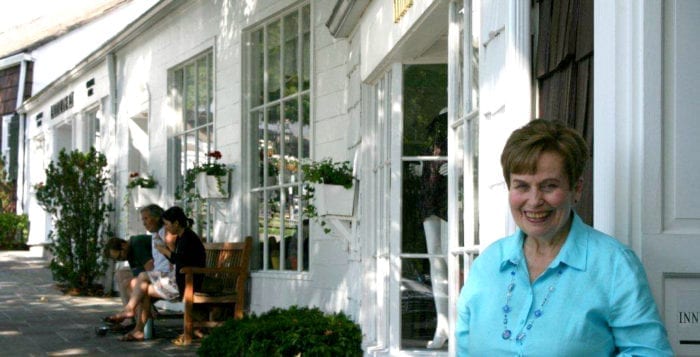One on One with Gloria Rocchio
By Katelyn Winter
In 1939 Ward Melville along with his wife Dorothy created a not-for-profit corporation, the Stony Brook Community Fund, later named The Ward Melville Heritage Organization, to maintain and protect the historical and sensitive environmental properties that he would deed to it over the coming years. 75 years later, the organization continues to thrive. I recently had the opportunity to interview Ms. Gloria Rocchio, president of The WMHO, in her office at the Stony Brook Village Center.
How did you get involved with the WMHO?
My husband and I moved here on Memorial Day in 1977, and we volunteered for the organization. Mr. Melville passed away on June 7, 1977. I looked out the window, and I asked myself, is everything going to change? So we volunteered for a year or so, and then my predecessor decided to retire. I wasn’t too interested in applying [for the position] because I was head of Long Island Convention and Visitors Bureau. My husband wanted me to, because he never saw me. I was traveling to Washington, Albany and all over Long Island. So I applied [because] after volunteering here for a couple of years, I thought I knew what should be changed. I told them what I thought at the interview, and as I was leaving, I thought, well I won’t be selected. And I was. 36 years later, here I am, and I love it.
So you’ve lived here since 1977?
Actually I’ve been coming here since 1959. My mother and I came here, and when I got married, it was the only place I wanted to live. [My husband and I] got married in Nassau County and we honeymooned at the Three Village Inn.
What do you love about being president of The WMHO?
Well, first of all, for the first ten years I worked for Mrs. Melville — she was president. She was a wonderful mentor; I learned everything from her. She guided me, she had a great sense of architecture, and she was just a very intelligent, brilliant lady. Every day is a challenge. When I hire people I always say you’ll never be bored again, and it’s true. It’s not for everybody, it’s 24/7, and I’m not a one-man band. I have a wonderful staff that’s very hard working and we have a board of trustees that are very interesting, community minded, selfless, dedicated, and many of the people in the community don’t know them but they’re there and we have many meetings throughout the year. I’m just happy to be here.
What do you love about Stony Brook Village, and what is your favorite season here?
Oh, I love it all, I can’t pick one over another. But season is probably the fall, it’s just beautiful. We own the wetlands, 88 acres of it, and [one day] Dr. [Erwin] Ernst and I took some elected officials to the Marine Conservation center in a boat. It was in October, and the grasses and the trees were so golden. It was [Ernst’s] idea to come up with a Discovery pontoon boat to go into the wetlands. It was so different than seeing it by land, and it has really amazed people. Twenty something years we’ve been doing it. I once got a call from a lady who said she wanted to “take that ride into the swamp.” The next day, she called and said, “I never knew anything about the importance of wetlands, and how they contribute to the ecosystem and the wildlife.” She said it was “phenomenal.” They’ve been giving us rave reviews ever since.
What is the story behind the portrait of George Washington that hangs behind your desk?
That’s a funny story, because for a while I didn’t know either. This is Mr. Melville’s office, and I’ve been sitting in front of this picture for 36 years. As the years went by, I started to understand why [it was there]. Mr. Melville purchased properties that had to do with early America and George Washington’s spy ring; he bought the Brewster House. He knew about that in 1942, and so he purchased the Grist Mill. All these things had to do with early America, and Mr. Melville was fascinated by George Washington and what he did, and I am too. I do a lot of research on the houses, and I learned that one of the Brewster’s was very involved in the construction of the King’s Highway, and that’s how I found out about Austin Roe. Now that’s the Heritage Trail. It’s all so important.
How is the ‘It Takes a Team to Build a Village’ exhibit going?
Very well. In fact, we had a reception fairly recently, and a lot of people came. The board said it’s so popular [that] we’re leaving it up as long as we can, because more and more people are finding out about it. We did this because it’s the 75th anniversary of the village, and most things that happened in this area came out of this organization. The archives are enormous. We started to look in boxes and we found an eight millimeter film. It said “The Village Dedication,” and we got it transferred so we could watch it. And son of a gun, it was a video of what Mr. Melville did on July 3, 1941! He had huge parades, and a beauty contest — which we wouldn’t do now. He dedicated the village from the balcony at the fire house. We thought we should do something like this, and we couldn’t do anything as grandiose as he did, but we had this nice little re-dedication on July 10, and it was great. Then we found extraordinary documents, and we’re hoping to get funding to work with Stony Brook University and the Frank Melville Memorial Library to digitize it all and create a website. It’s a huge undertaking but that’s what this has inspired us to do.
What would you say you are most proud of about your time with the WMHO?
One is the Walk for Beauty — 23 years, raising 1.3 million for breast cancer research. [Also] the Youth Corps — 20 years, putting through scores of children. We now have 69 children enrolled who will all know what Ward and Dorothy did here, and they can pay that forward and teach others. I’m proud of the Educational & Cultural Center we built, I’m proud of the Inner Court, where Crazy Beans is — that used to be storage sheds, and we converted them — and The Jazz Loft — I’m very proud of that.
Tell us what upcoming events you’re excited for people to enjoy.
Well, the website with the digitized documents is one. But we’ve also received a grant from the Robert D. L. Gardiner Foundation to do distance learning. What that means is that an instructor giving a lesson in, say, the Brewster House [in Setauket], would be filmed and onto the distance learning site so that people from around the world could learn about the rich history we have here. We already have the cameras installed in the Thompson House [in Setauket] and the Brewster House and we’re developing programs for them. One program should be ready this fall, and the other should be ready next spring. It’s very exciting.
Do you remember what your younger self wanted to be when you grew up?
It’s funny, I wanted to be an artist, and I was an artist, for a while. I went to Pratt College, went into that career, and felt too isolated — you painted alone. I like people. But this is kind of an art form, when you think about it. I worked for government, county executives for a while, but then got into, not events, but being head of promoting Long Island. It’s interesting; it’s definitely an art form, this place. Recently, I began to understand that Mr. Melville wanted us to live with history. We take it for granted, and we shouldn’t. It’s really a phenomenon, what we live with. This morning I got stopped by a resident who has lived here for a long time and she said, “I want to tell you, Gloria, that living here is like living in a park, it’s so beautiful. It’s just wonderful to have it this way.” And I told her, well, as long as we can, the organization plans to keep it that way. It gets more challenging with years. You try to respect the past, but we have to be current and relevant, and be receptive to change. That’s what we try to do.
If you had to pick an ice cream flavor to represent yourself, what would you choose?
Muddy boots! It’s from Latitude 121, it’s such a great flavor.
At the end of the charming and educational interview I had with Ms. Rocchio, she left me with a very inspiring piece of advice. It is a quote, originally by Kuan-Tzu from the third century BC. It is also part of the inscription on a plaque at the purple beech tree on the Stony Brook Village Green planted by Mrs. Dorothy Melville on her 88th birthday, and was incorporated into the speech given by Dr. Richard Rugen, chairman of the board of trustees of The WMHO, for the closing remarks of the 75th anniversary of Stony Brook Village July 10 of this year.
“If you plan for a year, sow a seed. If you plan for a decade, plant a tree.
If you plan for a century, educate the people.”
This simple quote compromises the heartfelt and dedicated mission of not only The Ward Melville Heritage Organization but of Ms. Rocchio herself.
Author Katelyn Winter is a rising junior at Muhlenberg College in Allentown, Pa., majoring in English and creative writing. She is from Stony Brook and hopes to one day work in the publishing industry.







